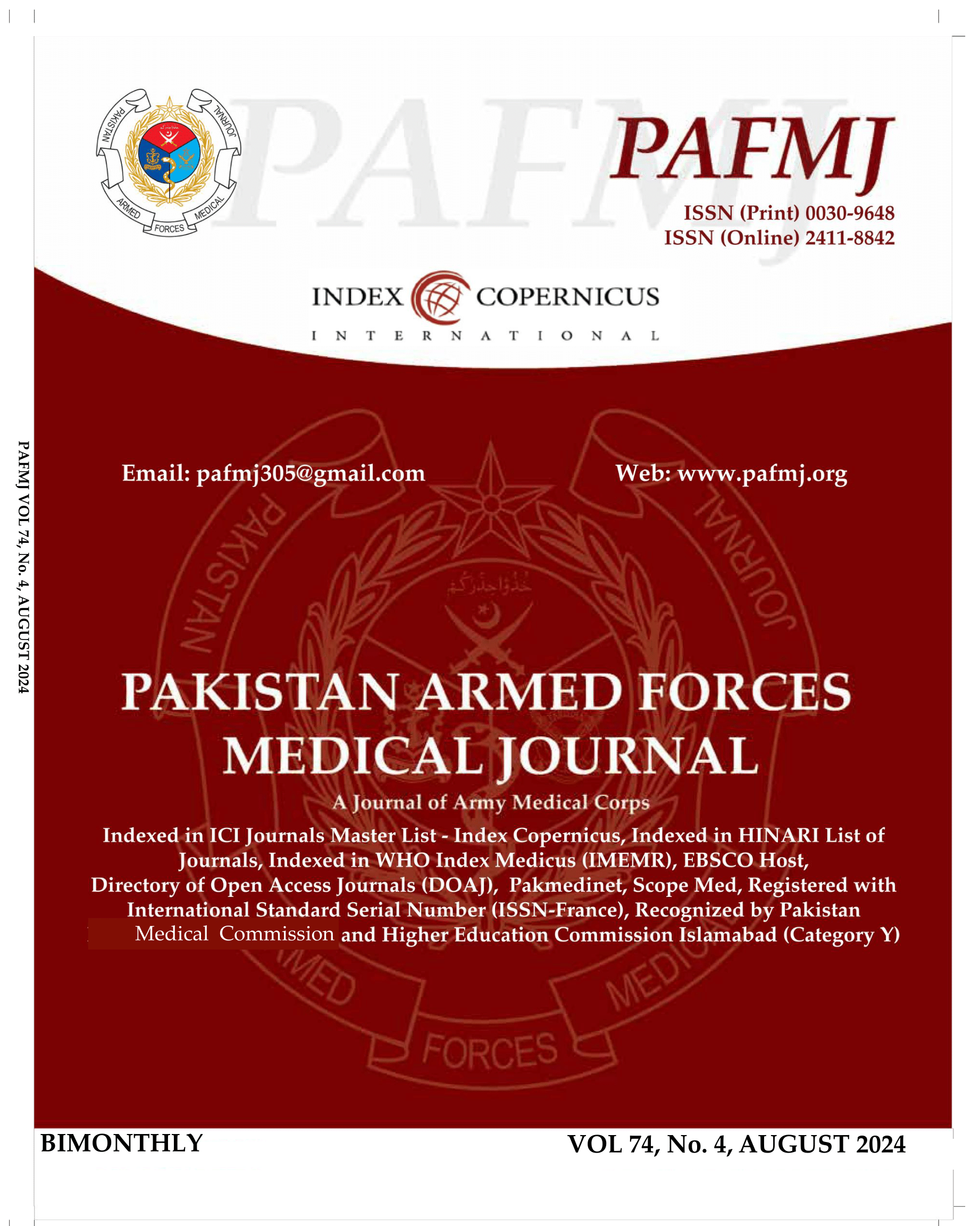Diagnostic Accuracy of C-Reactive Protein in Acute Appendicitis
DOI:
https://doi.org/10.51253/pafmj.v74i4.9109Keywords:
Acute appendicitis, Appendectomy, C-reactive protein (CRP), Diagnosis.Abstract
Objective: To determine diagnostic accuracy of C-reactive protein in acute appendicitis.
Study Design: Cross-sectional study.
Place and Duration of Study: Surgical unit Combined Military Hospital Gujranwala Pakistan, from Apr 2019 to Jan 2021.
Methodology: One hundred and twenty patients were included in the study following the inclusion criteria after their written permission and willingness. C-reactive protein levels were sent pre-operatively to the Pathology department of Combined Military Hospital Gujranwala. Patients were operated on by two classified surgeons. After open and laparoscopic appendectomies, specimens were sent to Histopathologists at Armed Forces Institute of Pathology Rawalpindi. Results were compared to determine the diagnostic accuracy of C-reactive protein.
Results: Out of 120 patients, 72(60%) were males and 48(40%) were females. The diagnostic accuracy of C-reactive protein in acute appendicitis was calculated by keeping tissue diagnosis histopathology as the gold standard, where 82(68.33%) were true positive, 7(5.84%) were false positive, 13(10.83%) were true negative, and 18(15%) were false negative. Sensitivity, specificity, positive predictive value, negative predictive value and diagnostic accuracy were 89.13%, 67.86%, 90.11%, 65.52% and 84.17% respectively.
Conclusion: The of C-reactive protein level test for the diagnosis of acute appendicitis was very sensitive but not very specific. C-reactive protein levels should be measured routinely in suspected cases of acute appendicitis, along with Total Leucocyte Count and ultrasound abdomen, as a useful marker for early diagnosis, thus reducing negative appendectomy rates.
Downloads
References
Becker C, Kharbanda A. Acute appendicitis in pediatric patients: an evidence-based review. Pediatr Emerg Med Pract 2019; 16(9): 1-20.
Kulvatunyou N, Zimmerman SA, Joseph B, Friese RS, Gries L, O'Keeffe T, et al. Risk Factors for Perforated Appendicitis in the Acute Care Surgery Era-Minimizing the Patient's Delayed Presentation Factor. J Surg Res 2019; 238: 113-118.
https://doi.org/10.1016/j.jss.2019.01.031
Xharra S, Gashi-Luci L, Xharra K, Veselaj F, Bicaj B, Sada F, et al. Correlation of serum C-reactive protein, white blood count and neutrophil percentage with histopathology findings in acute appendicitis. World J Emerg Surg 2012; 7(1): 27.
https://doi.org/10.1186/1749-7922-7-27
Alotaibi AM, Moshref LH, Moshref RH, Felemban LS. Analysis of 190 Female Patients after Appendectomy. Obstet Gynecol Int 2021; 2021: 8036970. https://doi.org/10.1155/2021/8036970
Vaughan-Shaw PG, Rees JR, Bell E, Hamdan M, Platt T. Normal inflammatory markers in appendicitis: evidence from two independent cohort studies. JRSM Short Rep 2011; 2(5): 43.
https://doi.org/10.1258/shorts.2011.010114
Hawkins AT, Wise PE, Chan T, Lee JT, Glyn T, Wood V, et al. Diverticulitis: An Update From the Age Old Paradigm. Curr Probl Surg 2020; 57(10): 100862.
https://doi.org/10.1016/j.cpsurg.2020.100862
Lo Bianco S, Cavallaro D, Provenzano D, Stracqualursi A, Leonardi A, Basile G, et al. Open mini-incision vs laparoscopic appendectomy A retrospective single Centre study. Ann Ital Chir 2021; 92: 1-5.
Hamill JK, Hill AG. A history of the treatment of appendicitis in children: lessons learned. ANZ J Surg 2016; 86(10): 762-767.
https://doi.org/10.1111/ans.13627
Pedram A, Asadian F, Roshan N. Diagnostic Accuracy of Abdominal Ultrasonography in Pediatric Acute Appendicitis. Bull Emerg Trauma 2019; 7(3): 278-283.
https://doi.org/10.29252/beat-0703011
Akhtar-Danesh GG, Doumouras AG, Flageole H, Hong D. Geographic and socioeconomic predictors of perforated appendicitis: A national Canadian cohort study. J Pediatr Surg 2019; 54(9): 1804-1808.
https://doi.org/10.1016/j.jpedsurg.2018.10.065
Kim MJ, Choi WH, Cheong JC, Choi SY, Kim JW, Park JH. Delta neutrophil index and symptomatic time are effective factors for predicting perforated appendicitis. Medicine 2021; 100(20): e25935. https://doi.org/10.1097/MD.0000000000025935
Castro ADAE, Skare TL, Yamauchi FI, Tachibana A, Ribeiro SPP, Fonseca EKUN, et al. Diagnostic value of c-reactive protein and the influence of visceral fat in patients with obesity and acute appendicitis. Arq Bras Cir Dig 2018; 31(1): e1339.
https://doi.org/10.1590/0102-672020180001e1339
Klein TT, Kohn E, Klin B, Ziv-Baran T, Kozer E, Berkovitch M, et al. sTREM-1 as a diagnostic biomarker for acute appendicitis in children. Asian J Surg 2021; 44(9): 1172-1178.
https://doi.org/10.1016/j.asjsur.2021.02.025
Kaya B, Sana B, Eris C, Karabulut K, Bat O, Kutanis R. et al. The diagnostic value of D-dimer, procalcitonin and CRP in acute appendicitis. Int J Med Sci 2012; 9(10): 909-915.
https://doi.org/10.7150/ijms.4733
Dadeh AA, Puitong K. Predictive Factors to Diagnose Appendicitis in Children in the Emergency Department. Open Access Emerg Med 2021; 13: 363-372.
https://doi.org/10.2147/OAEM.S323960
Schuppisser M, Khallouf J, Abbassi Z, Erne M, Vettorel D, Paroz A, et al. Abdominal Mondor disease mimicking acute appendicitis. Int J Surg Case Rep 2016; 20: 37-40.
https://doi.org/10.1016/j.ijscr.2015.12.031
Msolli MA, Beltaief K, Bouida W, Jerbi N, Grissa MH, Boubaker H, et al. Value of early change of serum C reactive protein combined to modified Alvarado score in the diagnosis of acute appendicitis. BMC Emerg Med 2018; 18(1): 15.
https://doi.org/10.1186/s12873-018-0166-5
Sushruth S, Vijayakumar C, Srinivasan K, Raj Kumar N, Balasubramaniyan G, Verma SK, et al. Role of C-Reactive Protein, White Blood Cell Counts, Bilirubin Levels, and Imaging in the Diagnosis of Acute Appendicitis as a Cause of Right Iliac Fossa Pain. Cureus 2018; 10(1): e2070.
Downloads
Published
Issue
Section
License
Copyright (c) 2024 Hassan Tariq, ShahumKhan, Shafqat Hussain, Ahmed Bilal, Muhammad Sajid Hussain

This work is licensed under a Creative Commons Attribution-NonCommercial 4.0 International License.















